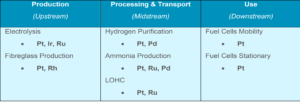Platinum Group Metals in the Hydrogen Economy Midstream
Executive Summary
Hydrogen end markets could account for 11% of total platinum demand by 2030, increasing from 40 koz in 2023 to around 900 koz in 2030, driven primarily by the use of platinum in upstream (electrolyzer) and downstream (hydrogen fuel cell) applications (Figure 1). Midstream applications have an important role in enabling market development and the establishment of a global trade in green hydrogen.
Hydrogen, particularly green hydrogen made from renewables, is essential for the energy transition due to its versatility as a fuel, chemical feedstock and energy carrier. Platinum Group Metals (PGMs) are critical for enabling the use of green hydrogen to achieve decarbonization goals. PGMs are used across the hydrogen value chain in a variety of applications that are important for the energy transition (Figure 2).
What is the hydrogen economy?
Understandably, the focus tends to be on the use of PGM catalysts in proton exchange membrane (PEM) technology in upstream (electrolyzer) and downstream (hydrogen fuel cell) applications. Of this demand, fuel cells used in both mobility (land, sea and air transport) and stationary applications comprise the largest segment of projected hydrogen-related platinum demand, which is forecast to reach over 600 koz by 2030.
However, PGM-based midstream applications, including hydrogen purification, hydrogen distribution and e-fuel production are also facilitating the development of the hydrogen economy, offering scope for PGM demand growth.
Figure 1: Forecast hydrogen-related platinum demand for platinum

Figure 2: Examples of upstream, midstream and downstream PGM applications
 Source: WPIC Research. LOHC = Liquid Organic Hydrogen Carrier
Source: WPIC Research. LOHC = Liquid Organic Hydrogen Carrier


Hi, this is a comment.
To get started with moderating, editing, and deleting comments, please visit the Comments screen in the dashboard.
Commenter avatars come from Gravatar.